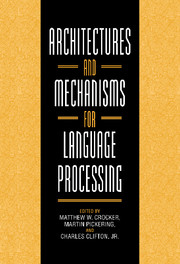Book contents
- Frontmatter
- Contents
- Contributors
- Preface
- 1 Architectures and Mechanisms in Sentence Comprehension
- Part I Frameworks
- 2 Evaluating Models of Human Sentence Processing
- 3 Specifying Architectures for Language Processing: Process, Control, and Memory in Parsing and Interpretation
- 4 Modeling Thematic and Discourse Context Effects with a Multiple Constraints Approach: Implications for the Architecture of the Language Comprehension System
- 5 Late Closure in Context: Some Consequences for Parsimony
- Part II Syntactic and Lexical Mechanisms
- Part III Syntax and Semantics
- Part IV Interpretation
- Author Index
- Subject Index
4 - Modeling Thematic and Discourse Context Effects with a Multiple Constraints Approach: Implications for the Architecture of the Language Comprehension System
Published online by Cambridge University Press: 03 October 2009
- Frontmatter
- Contents
- Contributors
- Preface
- 1 Architectures and Mechanisms in Sentence Comprehension
- Part I Frameworks
- 2 Evaluating Models of Human Sentence Processing
- 3 Specifying Architectures for Language Processing: Process, Control, and Memory in Parsing and Interpretation
- 4 Modeling Thematic and Discourse Context Effects with a Multiple Constraints Approach: Implications for the Architecture of the Language Comprehension System
- 5 Late Closure in Context: Some Consequences for Parsimony
- Part II Syntactic and Lexical Mechanisms
- Part III Syntax and Semantics
- Part IV Interpretation
- Author Index
- Subject Index
Summary
…And dicing Time for gladness casts a moan
These purblind Doomsters had as readily strown…
Thomas Hardy, Hap, 1866Introduction
The ambiguity problem takes center stage in models of sentence processing because, to a first approximation, linguistic input is presented sequentially to the processing system in both spoken language and in reading. Thus, even unambiguous sequences of speech or text are briefly ambiguous. A rich empirical database now demonstrates that the processing system makes partial commitments that are closely time-locked to the input as it unfolds over time (for recent reviews see Tanenhaus & Trueswell, 1995, Pickering, Clifton, & Crocker, this volume). Because the syntactic information available to the system at any point in the sentence often underdetermines its structure, other constraints that are correlated with the syntactic alternatives could, in principle, provide information that is useful for syntactic ambiguity resolution.
For more than a decade, researchers in the sentence processing community have been relying on data from increasingly fine-grained measures of processing difficulty, especially eye-movement data, in an attempt to adjudicate among competing models of how correlated constraints are used in ambiguity resolution. But despite a rapidly growing experimental literature, an increasingly rich empirical base, and a plethora of explicit parsing models, the basic architectural issues remain unresolved. We argue that this state of affairs is likely to continue until researchers in the sentence processing community begin to develop explicit quantitative models that (a) identify and quantify the relevant sources of constraint and (b) specify mechanisms that link information integration to processing time.
- Type
- Chapter
- Information
- Architectures and Mechanisms for Language Processing , pp. 90 - 118Publisher: Cambridge University PressPrint publication year: 1999
- 2
- Cited by



